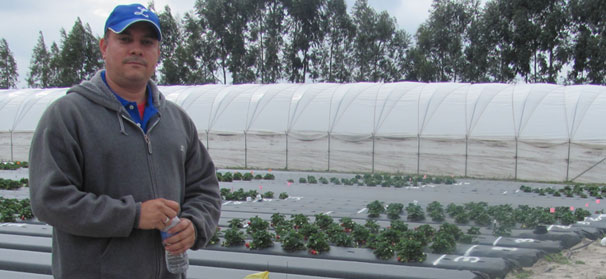

Apr 15, 2011Florida strawberry experiments conserve water
Several strawberry experiments at the University of Florida’s Gulf Coast Research & Education Center in Wimauma, Fla., are finding ways to preserve water.
Bielinski Santos, a vegetable and small fruit horticulturist, described some of the experiments for a group of growers Feb. 11, during the center’s strawberry expo.
One research experiment seeks to lower the amount of water used when establishing strawberries by using Surround crop protectant (kaolin clay). The research started four years ago, and includes small plots and large-scale field demonstrations in and around Plant City, Fla.
The conventional way to establish strawberries in Florida requires between 10 and 14 days of sprinkler irrigation (about 60,000 gallons per acre). In the experiment, the irrigation stops on day seven and Surround is applied on top of the plants the next morning. So far, the research has yielded a 20-30 percent savings in water, with no significant difference in plant growth or yield, according to Santos.
Another water-saving project compares plug plant establishment with bare-root transplant establishment. Three Florida cultivars were plugged on two dates. The bare-root transplants were established with regular sprinkler irrigation lasting 10 days, while the plug plants needed only two days of sprinkler irrigation. Preliminary results showed earlier yields with the plug plants, as well.
Saving water on plug plants is important, especially after the freezing events of the last two winters in Florida, when there wasn’t enough water for everybody, Santos said.
The center has used high tunnels for freeze protection for the last five years. This season, new freeze protection treatments were added, such as row covers (with and without mini hoops) and low-volume sprinklers that reduce the amount of water applied.
Besides freeze protection, tunnels and row covers save water. In open fields, about 60,000 gallons of water per acre are needed to combat freezing events – which, during typical Florida winters, occur on four or five nights. During the last two winters, however, the number of freezes nearly tripled, he said.
Water for freeze protection isn’t needed with tunnels or row covers, and the plants stay protected. Tunnels yield more berries with better postharvest quality.
But while tunnels and row covers protect plants and save water, that doesn’t mean they’re cheap. Besides the cost of the material, putting on and taking off row covers can cost thousands of dollars in labor – and the costs go up the more freezes you have, he said.
Santos and other researchers are still experimenting with hoop and tunnel combinations, to see which protects the crop most effectively – and which is the cheapest for growers to implement, he said.
By Matt Milkovich














